 The chemistry undergraduate REEL student presentations were held on May 12, 2014. The day started off with a luncheon served in the student lounge. The menu included chicken marsala, lasagna, curry chicken salad, BBQ ribs, shepherd’s pie, salad with fresh baked rolls, cookies and apple pie. This was a great way for the students to socialize and relax before a long afternoon of presentations. The students enthusiastically presented the research they conducted during the semester. Well done research and excellent presentations. Congratulations Students on a successful semester in REEL!!
The chemistry undergraduate REEL student presentations were held on May 12, 2014. The day started off with a luncheon served in the student lounge. The menu included chicken marsala, lasagna, curry chicken salad, BBQ ribs, shepherd’s pie, salad with fresh baked rolls, cookies and apple pie. This was a great way for the students to socialize and relax before a long afternoon of presentations. The students enthusiastically presented the research they conducted during the semester. Well done research and excellent presentations. Congratulations Students on a successful semester in REEL!!
Please scroll down to view the presentations.
Effect of Hard Water Mineral Content on Lipase Activity
Rachael Gollub, REEL General Chemistry Lab, Cleveland State University, Chemistry Department
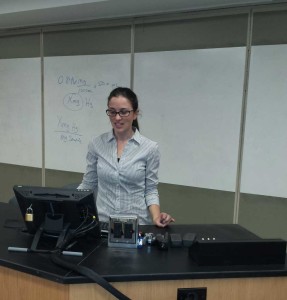 Lipase is an enzyme that is present in human breast milk and functions in the emulsification and digestion of lipids. Anecdotal evidence suggests that in certain cases, abnormally high activity of this enzyme causes premature digestion of lipids in breast milk that is pumped and stored for later use. Though the enzyme activity can be effectively inhibited by scalding (heating) the milk, doing so has also been found to reduce the beneficial immunological benefits inherent in breast milk. The purpose of this experiment was to examine the extrinsic effectors that may play a role on enzyme activity. Specifically, we studied metal ions of Calcium (a known enzyme activator) and Magnesium often found in hard water that may be used to clean milk pumping and storage equipment. With Triolein as a substrate for lipase, we used GC-MS to analyze lipid levels of solutions spiked with ions in similar levels to that may be found in residual tap water left on pumping and storage equipment. A 24 hour digestion period was allowed for the enzyme to act. After exposure, the concentration of lipids was analyzed indirectly through derivitization of polar portions of the lipids and by comparing results against a calibration curve of known concentrations of lipids. The analyzed samples showed increased lipase activity for the sample exposed to Ca2+, as well as for the sample containing both Ca2+ and Mg2+. Only mildly increased lipase activity was associated with the sample containing only Mg2+.
Lipase is an enzyme that is present in human breast milk and functions in the emulsification and digestion of lipids. Anecdotal evidence suggests that in certain cases, abnormally high activity of this enzyme causes premature digestion of lipids in breast milk that is pumped and stored for later use. Though the enzyme activity can be effectively inhibited by scalding (heating) the milk, doing so has also been found to reduce the beneficial immunological benefits inherent in breast milk. The purpose of this experiment was to examine the extrinsic effectors that may play a role on enzyme activity. Specifically, we studied metal ions of Calcium (a known enzyme activator) and Magnesium often found in hard water that may be used to clean milk pumping and storage equipment. With Triolein as a substrate for lipase, we used GC-MS to analyze lipid levels of solutions spiked with ions in similar levels to that may be found in residual tap water left on pumping and storage equipment. A 24 hour digestion period was allowed for the enzyme to act. After exposure, the concentration of lipids was analyzed indirectly through derivitization of polar portions of the lipids and by comparing results against a calibration curve of known concentrations of lipids. The analyzed samples showed increased lipase activity for the sample exposed to Ca2+, as well as for the sample containing both Ca2+ and Mg2+. Only mildly increased lipase activity was associated with the sample containing only Mg2+.
Determination of Chromium and Lead Soil Concentrations in Hough and Lyndhurst
Nick Zielinski, REEL General Chemistry Lab, Department of Chemistry, Cleveland State University
 The Cleveland communities of Hough and Lyndhurst are home to a 24 year disparity in life expectancies. Social determinants of health have been indicated as the major contributors to this disparity. Nevertheless, this project seeks to compare lead and chromium levels between the two communities. Inductively coupled plasma was utilized as a forensic tool in determining concentrations of lead and chromium in each community. Both lead and chromium were present in higher concentration in the Hough area of Cleveland.
The Cleveland communities of Hough and Lyndhurst are home to a 24 year disparity in life expectancies. Social determinants of health have been indicated as the major contributors to this disparity. Nevertheless, this project seeks to compare lead and chromium levels between the two communities. Inductively coupled plasma was utilized as a forensic tool in determining concentrations of lead and chromium in each community. Both lead and chromium were present in higher concentration in the Hough area of Cleveland.
Comparing The Concentration of Mercury in Farm Raised, Regular Filet, And Wild Caught Salmons
Marcel L Mpiana, REEL General Chemistry Lab, Department of Chemistry, Cleveland State University
 Salmon is one of the most important fish species due to its frequency of consumption in the US. Seafood consumption has various health benefits, but the main concern with it is the presence of mercury (Hg) that is considered hazardous for human’s heath, especially in pregnant women (1). In this study, we looked at three different type of salmons found in the Us market including a salmon filet, a farm raised salmon, and a wild caught salmon and studied them to determine their respective Hg level in order to determine which type is safer for consumption. The results indicate that the level of Hg is significantly higher (about eight times more) in the farm-raised salmon compared to the wild caught, and significantly higher than the salmon filet as well. More studies are needed in order to verify repeatability, and also to review the NOAA suggestion on consuming salmon from aquaculture
Salmon is one of the most important fish species due to its frequency of consumption in the US. Seafood consumption has various health benefits, but the main concern with it is the presence of mercury (Hg) that is considered hazardous for human’s heath, especially in pregnant women (1). In this study, we looked at three different type of salmons found in the Us market including a salmon filet, a farm raised salmon, and a wild caught salmon and studied them to determine their respective Hg level in order to determine which type is safer for consumption. The results indicate that the level of Hg is significantly higher (about eight times more) in the farm-raised salmon compared to the wild caught, and significantly higher than the salmon filet as well. More studies are needed in order to verify repeatability, and also to review the NOAA suggestion on consuming salmon from aquaculture
TRIFLURALIN: HOW COMMON HERBICIDES MAY BE CONTAMINATING LOCAL WELL WATER
Robert Becker and Wendy Slone, REEL Organic Chemistry Lab, Department of Chemistry, Cleveland State University
 Trifluralin is a selective dinitroaniline herbicide used to control a variety of annual grasses and broadleaf weeds. Commonly available as a pre-emergent in residential and commercial agribusiness, Trifluralin can leach into water systems and contribute to disease and health issues for humans. Problems associated with Trifluralin have been documented in the World Health Organization’s Guidelines for Drinking Water Quality, including increased risks for certain cancers, such as non-Hodgkin lymphoma. Green, Ohio is a small city located in the southeast corner of Summit County. Traditionally a rural township until incorporation in 1992, Green still has significant portions dedicated to agricultural purposes such as raising animal stock, commercial row farming and retail fruit orchards. Additionally, these sparsely developed areas of Green are interspersed with an array of surface water ponds, bogs and lakes, including the 500-acre Singer Lake Conservancy owned by the Cleveland Museum of Natural History. Residential homes in these areas of Green use shallow to moderate depth vertical wells as a potable water source and are thus subject to ground water contaminants. The focus of this study is to analyze selected samples of drinking water from this area to test for the presence of Trifluralin. Our results indicate that Trifluralin was not found in causative levels sufficient for health issues in humans.
Trifluralin is a selective dinitroaniline herbicide used to control a variety of annual grasses and broadleaf weeds. Commonly available as a pre-emergent in residential and commercial agribusiness, Trifluralin can leach into water systems and contribute to disease and health issues for humans. Problems associated with Trifluralin have been documented in the World Health Organization’s Guidelines for Drinking Water Quality, including increased risks for certain cancers, such as non-Hodgkin lymphoma. Green, Ohio is a small city located in the southeast corner of Summit County. Traditionally a rural township until incorporation in 1992, Green still has significant portions dedicated to agricultural purposes such as raising animal stock, commercial row farming and retail fruit orchards. Additionally, these sparsely developed areas of Green are interspersed with an array of surface water ponds, bogs and lakes, including the 500-acre Singer Lake Conservancy owned by the Cleveland Museum of Natural History. Residential homes in these areas of Green use shallow to moderate depth vertical wells as a potable water source and are thus subject to ground water contaminants. The focus of this study is to analyze selected samples of drinking water from this area to test for the presence of Trifluralin. Our results indicate that Trifluralin was not found in causative levels sufficient for health issues in humans.
Assessment of heavy metals in athletic clothing using artificial sweat
Catherine Waddell, REEL General Chemistry Lab, Department of Chemistry, Cleveland State University
 Many heavy metals that pose a risk to human health are routinely used in the manufacture of clothing. There is growing concern about the ability of heavy metals to transfer from clothing to the skin and into the body, resulting in potentially harmful dermal and sub-dermal effects. Four items of athletic clothing were evaluated for the presence of heavy metals. Antimony and lead were extracted at concentrations between 0.2478-0.3076 ppm and 0.6107-0.9616 ppm, respectively, when fabric samples were treated with 10% nitric acid. Fabric samples subjected to pre-washing prior to analysis exhibited up to a 52% decrease in the concentration of lead. Fabric samples treated with a neutral artificial sweat solution showed a reduction in extraction concentration for lead and antimony by up to 59% when compared to samples extracted with 10% nitric acid. These findings confirm the presence of heavy metals in athletic clothing. They also indicate that, although an artificial sweat solution at a neutral pH is less effective at extracting heavy metals than a 10% nitric acid solution, it can still effectively extract heavy metals from clothing thus leaving open the possibility that the skin may absorb these metals.
Many heavy metals that pose a risk to human health are routinely used in the manufacture of clothing. There is growing concern about the ability of heavy metals to transfer from clothing to the skin and into the body, resulting in potentially harmful dermal and sub-dermal effects. Four items of athletic clothing were evaluated for the presence of heavy metals. Antimony and lead were extracted at concentrations between 0.2478-0.3076 ppm and 0.6107-0.9616 ppm, respectively, when fabric samples were treated with 10% nitric acid. Fabric samples subjected to pre-washing prior to analysis exhibited up to a 52% decrease in the concentration of lead. Fabric samples treated with a neutral artificial sweat solution showed a reduction in extraction concentration for lead and antimony by up to 59% when compared to samples extracted with 10% nitric acid. These findings confirm the presence of heavy metals in athletic clothing. They also indicate that, although an artificial sweat solution at a neutral pH is less effective at extracting heavy metals than a 10% nitric acid solution, it can still effectively extract heavy metals from clothing thus leaving open the possibility that the skin may absorb these metals.
Detection of Polycyclic Aromatic Hydrocarbons in Candle Burning Emissions
Ford, D., Jedlicka, M.A., Kellogg, J.
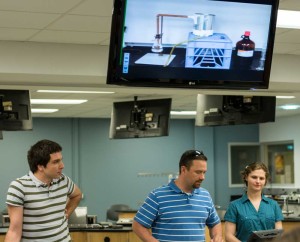 The burning of scented candles indoors can release several toxic pollutants in the air making it harmful to breathe; however, the popularity of the practice is widespread. Dangers associated with indoor candle burning can be attributed to both organic and inorganic substances. This paper investigates whether Polycyclic Aromatic Hydrocarbons (PAHs) are emitted during the burning of scented candles in an indoor setting by burning candles in a specialized burn chamber designed to capture the emissions. The pollutants released by scented candles can differ, possibly due to the different scent additives in each candle. With air pollutants varying from candle to candle, an examination of the indoor pollutants emitted by every candle on the market is necessary in order to determine the possible health hazards that may be present. Conclusive quantitative data on the presence of fluorene, benzo[a]pyrene, and phenanthrene, was not obtainable. It is possible our PAH’s of interest may have been present in the smoke samples, but at too low of a concentration based on detection limits of GC/MS. Since the literature supports these PAH’s would be present, we recommend repeating the experiment with longer burn times and more concentrated samples. Based on a library search on the GC/MS spectrum, the data suggests that Chrysene and benzo[a]pyrene were present in the samples. Similarly, we detected phthalates in both candle samples. Without standards to quantify the amounts, these supportive findings remain purely qualitative in our report. While we cannot quantify our results, the findings of our project warrant further investigation.
The burning of scented candles indoors can release several toxic pollutants in the air making it harmful to breathe; however, the popularity of the practice is widespread. Dangers associated with indoor candle burning can be attributed to both organic and inorganic substances. This paper investigates whether Polycyclic Aromatic Hydrocarbons (PAHs) are emitted during the burning of scented candles in an indoor setting by burning candles in a specialized burn chamber designed to capture the emissions. The pollutants released by scented candles can differ, possibly due to the different scent additives in each candle. With air pollutants varying from candle to candle, an examination of the indoor pollutants emitted by every candle on the market is necessary in order to determine the possible health hazards that may be present. Conclusive quantitative data on the presence of fluorene, benzo[a]pyrene, and phenanthrene, was not obtainable. It is possible our PAH’s of interest may have been present in the smoke samples, but at too low of a concentration based on detection limits of GC/MS. Since the literature supports these PAH’s would be present, we recommend repeating the experiment with longer burn times and more concentrated samples. Based on a library search on the GC/MS spectrum, the data suggests that Chrysene and benzo[a]pyrene were present in the samples. Similarly, we detected phthalates in both candle samples. Without standards to quantify the amounts, these supportive findings remain purely qualitative in our report. While we cannot quantify our results, the findings of our project warrant further investigation.
Survey of Chemical Leaching: Detection of Formaldehyde in PET Water Bottles
Ericka Roy, REEL Organic General Chemistry, Department of Chemistry, Cleveland State University
 Polyethylene terephthalate (PET) bottles are commonly used in packaging drinking water. The migration of formaldehyde into water from PET bottles was observed in our study. GC-MS was used to detect concentrations of formaldehyde in various water samples. High temperatures, sunlight exposure, and quality of PET plastics were found to be factors in the concentration levels of formaldehyde detected. Certain types of PET plastics are more sensitive to temperature and/or light. Further studies are needed to determine the nature of interaction between heat and sunlight during carbonyl migration, to explore the differences between recycled and non-recycled materials, and to verify the relationship between quality of PET plastics and migration of formaldehyde.
Polyethylene terephthalate (PET) bottles are commonly used in packaging drinking water. The migration of formaldehyde into water from PET bottles was observed in our study. GC-MS was used to detect concentrations of formaldehyde in various water samples. High temperatures, sunlight exposure, and quality of PET plastics were found to be factors in the concentration levels of formaldehyde detected. Certain types of PET plastics are more sensitive to temperature and/or light. Further studies are needed to determine the nature of interaction between heat and sunlight during carbonyl migration, to explore the differences between recycled and non-recycled materials, and to verify the relationship between quality of PET plastics and migration of formaldehyde.
Determination and Comparison of Heavy Metals in Selected Locally Grown and Store Bought Produce
Aicha Quamine, General Chemistry REEL Lab, Cleveland State University
 Various heavy metals such as Cadmium, Chromium and Mercury are well known carcinogens and quite dangerous to the environment and its inhabitants. Naturally, there are miniscule traces of these heavy metals everywhere on the Earth. For this reason, it is important to monitor our ingestion and absorption of these chemicals, and to differentiate the hazards between extremely high levels of toxicity, and levels which are not detrimental to animals, humans or the ecosystem. Due to Cleveland’s industrial past, there is a high risk of heavy metal contamination in soils, produce, and numerous other environmental mediums. Pre-existing chemicals have long since settled in our grounds, possibly leaching into plants and consumer produce.
Various heavy metals such as Cadmium, Chromium and Mercury are well known carcinogens and quite dangerous to the environment and its inhabitants. Naturally, there are miniscule traces of these heavy metals everywhere on the Earth. For this reason, it is important to monitor our ingestion and absorption of these chemicals, and to differentiate the hazards between extremely high levels of toxicity, and levels which are not detrimental to animals, humans or the ecosystem. Due to Cleveland’s industrial past, there is a high risk of heavy metal contamination in soils, produce, and numerous other environmental mediums. Pre-existing chemicals have long since settled in our grounds, possibly leaching into plants and consumer produce.
In recent years there has been a great push for more locally grown, environmentally friendly practices for generating sustainable foods. While this idea is a great concept in theory, it is important to take into acknowledge the remnants of chemical pollutants that have been left behind to accumulate in Cleveland soils throughout the decades1. By analyzing 3 different sets of fruits, we can utilize Inductively-Coupled Plasma (ICP-AES) analytical technique to gain better insight into how healthy Cleveland’s locally grown harvest is. In addition to assisting with environmental awareness, this information will provide consumers with a better understanding of the quality of fruits and vegetables grown on urban farms. Results obtained from the environmental samples were above the standard limits provided by the EPA, but the levels of contamination were constant.
Presence of Mercury, Cadmium, and Chromium in Water and Soil/Sediment of Tinker’s Creek, Cleveland Metroparks South Chagrin and Bedford Reservations
Kate Kelley, REEL General Chemistry Lab, Department of Chemistry, Cleveland State University
 This research examines the concentration of three heavy metals—mercury, cadmium, and chromium—in Tinker’s Creek of the South Chagrin and Bedford Reservations of the Cleveland Metroparks. Total mercury levels were tested, which includes organic and inorganic forms. Tinker’s Creek borders the Waste Management, Inc. landfill, and this project aims to discover if metals from improper cell phone disposal have leeched from the landfill to Tinker’s Creek. Three different sample sites were analyzed—upstream, at, and downstream from the landfill. Water and soil samples were digested with nitric acid, as well as with hydrochloric acid, and filtered. Samples were then run through an inductively coupled plasma spectroscopy device (ICP) to detect the intensity and to calculate concentration based on the linear equation of the metals’ standard curves. Mercury and chromium were detected; however, cadmium had a negative concentration. Mercury had the highest concretion, especially in the soil at Site 2 (at the landfill). This concentration was 1.3875 mg/L. Further research into mercury concentration in the soil and water of Tinker’s Creek that border the Waster Management, Inc. landfill, especially the organic more dangerous form of mercury, methylmercury, is warranted.
This research examines the concentration of three heavy metals—mercury, cadmium, and chromium—in Tinker’s Creek of the South Chagrin and Bedford Reservations of the Cleveland Metroparks. Total mercury levels were tested, which includes organic and inorganic forms. Tinker’s Creek borders the Waste Management, Inc. landfill, and this project aims to discover if metals from improper cell phone disposal have leeched from the landfill to Tinker’s Creek. Three different sample sites were analyzed—upstream, at, and downstream from the landfill. Water and soil samples were digested with nitric acid, as well as with hydrochloric acid, and filtered. Samples were then run through an inductively coupled plasma spectroscopy device (ICP) to detect the intensity and to calculate concentration based on the linear equation of the metals’ standard curves. Mercury and chromium were detected; however, cadmium had a negative concentration. Mercury had the highest concretion, especially in the soil at Site 2 (at the landfill). This concentration was 1.3875 mg/L. Further research into mercury concentration in the soil and water of Tinker’s Creek that border the Waster Management, Inc. landfill, especially the organic more dangerous form of mercury, methylmercury, is warranted.
Analysis of Diethyl and Dibutyl Phthalates in Charms Blow Pops
Victoria Gruber, REEL Organic Chemistry Lab, Department of Chemistry
 Phthalates are commonly used as plastic softeners to make plastic products more flexible and harder to break1. In recent years, phthalates have been found in a variety of packaged foods. It has been determined by previous research that the consumption of phthalates can be harmful to several organ systems including the Digestive (liver), Urinary (kidneys), Endocrine, and Reproductive systems2. This research focused on identifying the presence of two common phthalates, Diethyl Phthalate and Dibutyl Phthalate, in Charm’s Blow Pops through Gas Chromatography-Mass Spectrometry analysis. The research was based upon the hypothesis that the Blow Pops would absorb phthalates from their plastic wrappers, and included additional experimental parameters to see if the potential absorption would be affected by variations in temperature, since typical lollipops melt in higher temperatures and become more brittle in lower temperatures. Additionally, experimental parameters were implemented to determine if a larger surface area may affect the concentration of absorbed phthalates. Diethyl or Dibutyl Phthalate was not detected in either the Charms Blow Pops or wrapper samples.
Phthalates are commonly used as plastic softeners to make plastic products more flexible and harder to break1. In recent years, phthalates have been found in a variety of packaged foods. It has been determined by previous research that the consumption of phthalates can be harmful to several organ systems including the Digestive (liver), Urinary (kidneys), Endocrine, and Reproductive systems2. This research focused on identifying the presence of two common phthalates, Diethyl Phthalate and Dibutyl Phthalate, in Charm’s Blow Pops through Gas Chromatography-Mass Spectrometry analysis. The research was based upon the hypothesis that the Blow Pops would absorb phthalates from their plastic wrappers, and included additional experimental parameters to see if the potential absorption would be affected by variations in temperature, since typical lollipops melt in higher temperatures and become more brittle in lower temperatures. Additionally, experimental parameters were implemented to determine if a larger surface area may affect the concentration of absorbed phthalates. Diethyl or Dibutyl Phthalate was not detected in either the Charms Blow Pops or wrapper samples.
Determination of Ethylparaben Presence in Cosmetic Lotions Using High-Performance Liquid Chromatography
April Miller and Elizabeth Koduru, REEL General Chemistry Lab, Department of Chemistry, Cleveland State University
 Parabens are chemical ethers found in cosmetic products and are used as preservatives and antibacterial agents. They are known as endocrine disruptors and believed to be at the root of other health problems. This experiment was conducted to test for ethylparaben presence in scented lotions, and to compare the results to a set of identical samples spiked with a known concentration of ethylparaben solution to ensure a presence would be detected by the methods used. The sample preparations were created through an extraction and filtration process and the use of high performance liquid chromatography (HPLC). When compared to the calibration curve ranging from 0 to 200 ppm, the methods followed in this experiment determine the concentration present in the lotion extracts. This concentration is compared to the minimum inhibitory concentration of ethylparaben required to prohibit yeast, mold, and bacteria growth. The research has also provided reason to believe that ethylparaben is present in two of the samples tested, however, numerous sources of error compromised the accuracy of the experiment.
Parabens are chemical ethers found in cosmetic products and are used as preservatives and antibacterial agents. They are known as endocrine disruptors and believed to be at the root of other health problems. This experiment was conducted to test for ethylparaben presence in scented lotions, and to compare the results to a set of identical samples spiked with a known concentration of ethylparaben solution to ensure a presence would be detected by the methods used. The sample preparations were created through an extraction and filtration process and the use of high performance liquid chromatography (HPLC). When compared to the calibration curve ranging from 0 to 200 ppm, the methods followed in this experiment determine the concentration present in the lotion extracts. This concentration is compared to the minimum inhibitory concentration of ethylparaben required to prohibit yeast, mold, and bacteria growth. The research has also provided reason to believe that ethylparaben is present in two of the samples tested, however, numerous sources of error compromised the accuracy of the experiment.
Determination of Triclosan Levels in Antibacterial Hand Soaps Using HPLC
Taylor Deady, REEL Chemistry Organic Lab, Department of Chemistry, Cleveland State University
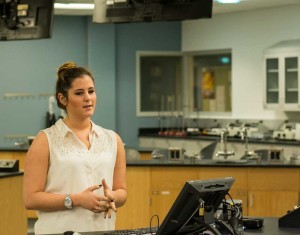 Everyone uses hand soap every single day (or at least they should), but what exactly is in hand soap? A recent issue that has been found in many antibacterial cosmetic products is the use of triclosan (TCS) as an antimicrobial agent. Triclosan is an organic contaminant with small evidence of endocrine disruptors and carcinogenic tendencies. This research was designed to test the triclosan levels within four common types of antibacterial hand soap using HPLC. The main finding was a small level of TCS in the specific brand, DG. The other 3 brands tested, showed no evidence of triclosan absorbance through the HPLC. Further testing should be done on each of these products, to determine whether they are completely safe for human use.
Everyone uses hand soap every single day (or at least they should), but what exactly is in hand soap? A recent issue that has been found in many antibacterial cosmetic products is the use of triclosan (TCS) as an antimicrobial agent. Triclosan is an organic contaminant with small evidence of endocrine disruptors and carcinogenic tendencies. This research was designed to test the triclosan levels within four common types of antibacterial hand soap using HPLC. The main finding was a small level of TCS in the specific brand, DG. The other 3 brands tested, showed no evidence of triclosan absorbance through the HPLC. Further testing should be done on each of these products, to determine whether they are completely safe for human use.
Determination of Arsenic in Various Apple Juice Brands
Julia Swit, REEL General Chemistry Lab, Department of Chemistry, Cleveland State University
 Various apple juice brands were brought into the lab to be analyzed. A stock solution was prepared with a concentration of 1000 ppm and consisting of 2% HNO_3 (Nitric Acid) and the designated arsenic compound, sodium arsenite (NaAsO2). Standards were then prepared with six concentrations ranging from 25 ppm to 0.8ppm, followed by six samples that were prepared and specifically labeled with one of six apple juices. After standard and sample preparation, all solutions underwent testing through ICP-OES (inductively coupled plasma optical emission spectroscopy), resulting in various levels of intensity and concentration values for each solution. ICP-OES results showed that the concentrations of arsenic in the apple juice itself were twice the concentrations of the overall samples which consisted of 50% apple juice. Therefore, the concentrations of arsenic in the samples were doubled to calculate the amount of arsenic in milligrams (mg) in various apple juices and were thus ranked from highest to lowest amount of arsenic in milligrams per liter of apple juice.
Various apple juice brands were brought into the lab to be analyzed. A stock solution was prepared with a concentration of 1000 ppm and consisting of 2% HNO_3 (Nitric Acid) and the designated arsenic compound, sodium arsenite (NaAsO2). Standards were then prepared with six concentrations ranging from 25 ppm to 0.8ppm, followed by six samples that were prepared and specifically labeled with one of six apple juices. After standard and sample preparation, all solutions underwent testing through ICP-OES (inductively coupled plasma optical emission spectroscopy), resulting in various levels of intensity and concentration values for each solution. ICP-OES results showed that the concentrations of arsenic in the apple juice itself were twice the concentrations of the overall samples which consisted of 50% apple juice. Therefore, the concentrations of arsenic in the samples were doubled to calculate the amount of arsenic in milligrams (mg) in various apple juices and were thus ranked from highest to lowest amount of arsenic in milligrams per liter of apple juice.
A Comparison of Eicosapentaenoic Acid Concentration in Fish Oil Supplements With Manufacturer Labels
Jill Mohr and Megan Beus, REEL Organic Chemistry Lab, Department of Chemistry, Cleveland State University
 Eicosapentaenoic acid is an essential omega-3 fatty acid often taken in fish oil supplements. Four different brands of fish oil pills were chosen for analysis of Eicosapentaenoic acid content by gas-chromatography mass-spectrometry (GC/MS). The results obtained from this analysis were compared to the amount of Eicosapentaenoic acid on the manufacturer labels. Based on the information presented in Table 4, every brand but Sam’s Club contained more EPA than what is stated on the label. Further investigation needs to be conducted in order to obtain conclusive results.
Eicosapentaenoic acid is an essential omega-3 fatty acid often taken in fish oil supplements. Four different brands of fish oil pills were chosen for analysis of Eicosapentaenoic acid content by gas-chromatography mass-spectrometry (GC/MS). The results obtained from this analysis were compared to the amount of Eicosapentaenoic acid on the manufacturer labels. Based on the information presented in Table 4, every brand but Sam’s Club contained more EPA than what is stated on the label. Further investigation needs to be conducted in order to obtain conclusive results.
Photolytic Degradation of Polycyclic Aromatic Hydrocarbons
Spencer Hopkins, & Nijal Patel, REEL Organic Chemistry Lab, Department of Chemistry, Cleveland State University
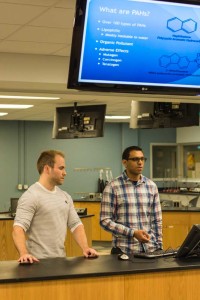 Naphthalene and 2-nitrofluorene (2-NF) are polycyclic aromatic hydrocarbons that were placed in organic solvents and prepped for photolytic degradation using titanium (IV) oxide as the photocatalyst, and broad-spectrum UV irradiation. Naphthalene was placed in a benzene solvent and underwent one hour of UV irradiation with continuous stirring of titanium (IV) oxide in an isothermal environment. 2-Nitrofluorene was found to be unstable in any organic solvent introduced to the substance, and experimental trials were ceased due to this circumstance. Experimental trials were analyzed through the use of gas chromatography mass spectroscopy. Upon irradiation of naphthalene with broad spectrum UV light, photolytic degradation was not observed; however, an increase in naphthalene concentration was observed. The possible explanation of the increase in concentration is provided.
Naphthalene and 2-nitrofluorene (2-NF) are polycyclic aromatic hydrocarbons that were placed in organic solvents and prepped for photolytic degradation using titanium (IV) oxide as the photocatalyst, and broad-spectrum UV irradiation. Naphthalene was placed in a benzene solvent and underwent one hour of UV irradiation with continuous stirring of titanium (IV) oxide in an isothermal environment. 2-Nitrofluorene was found to be unstable in any organic solvent introduced to the substance, and experimental trials were ceased due to this circumstance. Experimental trials were analyzed through the use of gas chromatography mass spectroscopy. Upon irradiation of naphthalene with broad spectrum UV light, photolytic degradation was not observed; however, an increase in naphthalene concentration was observed. The possible explanation of the increase in concentration is provided.
Analysis of Metals In Vitamin/Dietary Supplements
Saeed Khoncarly, REEL General Chemistry Lab, Department of Chemistry, Cleveland State University
 Millions of people use vitamins in the hope for it improving their health. Vitamins are essential for a number of reasons. In general vitamins keep our skin, hair, eyes, bones, teeth, nerves and blood cells healthy and normal. Some also assist in processing carbohydrates, proteins and fats. They assist in converting fat and carbohydrates into energy and assist in forming bone and tissue. However, in each vitamin/dietary supplements, there are inorganic minerals that can help improve ones health. With all these inorganic minerals and metals, the human body has a tolerance level for each of these metals. The purpose of this project is to determine the concentration of the metals in certain daily vitamin and dietary supplements and to compare them to the recommended daily intake and unhealthy intake as stated by the FDA. Centrum Adults Multivitamin was over the unhealthy limit for Iron by 0.48mg. Centrum Women’s 50+ was over the recommended daily intake but under the unhealthy limit for copper. Finally, in the Flintstones Gummies and Centrum Women’s 50+, the Zinc levels were well over the recommended daily intake and close to the unhealthy limit. Zinc is an essential trace element for the human body. Zinc in its excess can lead to the body’s retention of copper. The decreased levels in copper interfere with the production of lipoproteins which leads to increased levels of LDL and decreased levels of HDL cholesterol. (3) Although Zinc is not a carcinogen for humans, it can be dangerous in its excess, especially for the children who are taking vitamin supplements. All of the other vitamins that were analyzed were under the recommended daily intake and thus deemed safe
Millions of people use vitamins in the hope for it improving their health. Vitamins are essential for a number of reasons. In general vitamins keep our skin, hair, eyes, bones, teeth, nerves and blood cells healthy and normal. Some also assist in processing carbohydrates, proteins and fats. They assist in converting fat and carbohydrates into energy and assist in forming bone and tissue. However, in each vitamin/dietary supplements, there are inorganic minerals that can help improve ones health. With all these inorganic minerals and metals, the human body has a tolerance level for each of these metals. The purpose of this project is to determine the concentration of the metals in certain daily vitamin and dietary supplements and to compare them to the recommended daily intake and unhealthy intake as stated by the FDA. Centrum Adults Multivitamin was over the unhealthy limit for Iron by 0.48mg. Centrum Women’s 50+ was over the recommended daily intake but under the unhealthy limit for copper. Finally, in the Flintstones Gummies and Centrum Women’s 50+, the Zinc levels were well over the recommended daily intake and close to the unhealthy limit. Zinc is an essential trace element for the human body. Zinc in its excess can lead to the body’s retention of copper. The decreased levels in copper interfere with the production of lipoproteins which leads to increased levels of LDL and decreased levels of HDL cholesterol. (3) Although Zinc is not a carcinogen for humans, it can be dangerous in its excess, especially for the children who are taking vitamin supplements. All of the other vitamins that were analyzed were under the recommended daily intake and thus deemed safe
Determination of Heavy Metals in Soil Samples From Mills Creek at Johns Mills Park
DeAndrea Burnett Pruitt & Michael Spieth, REEL General Chemistry Lab, Department of Chemistry, Cleveland State University
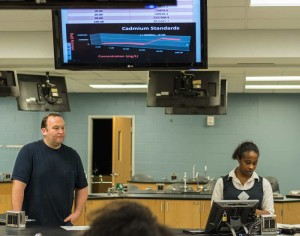 Soil contamination is typically caused by industrial activity, agricultural chemicals, or improper disposal of waste. In an effort to promote healthy living trails and walking paths are being introduced at Mills Creek at Johnson Mills Park, an area that people tend to use as a dump site. For this experiment we are calculating the levels of Cadmium, lead and Mercury that can be contained in the water and ground around the creek. The most common dumped items were tires, plastic bottles and basic household items. Analysis of the data showed that the levels of cadmium, Lead and Mercury were not high enough to cause harm to humans that interact in the creek.
Soil contamination is typically caused by industrial activity, agricultural chemicals, or improper disposal of waste. In an effort to promote healthy living trails and walking paths are being introduced at Mills Creek at Johnson Mills Park, an area that people tend to use as a dump site. For this experiment we are calculating the levels of Cadmium, lead and Mercury that can be contained in the water and ground around the creek. The most common dumped items were tires, plastic bottles and basic household items. Analysis of the data showed that the levels of cadmium, Lead and Mercury were not high enough to cause harm to humans that interact in the creek.
Determination of the Effectiveness of Clay to Remove Toxic Metals while Increasing the Concentrations of Essential Minerals
Tericka Henderson, REEL General Chemistry Lab, Department of Chemistry, Cleveland State University
 In today’s world we experience a variety of health problems that were never a previous concern. Researchers have linked many of the new epidemics to the greater amount of toxins humans are exposed to. It has become increasingly impossible to stay away from the toxins in todays world. This is the reason many have turned to the option of detoxification. Clay, has been used for centuries to detoxify the body and is believed by many to be the greatest detox of them all. The methods for proving or disproving this claim included replicating a plausible mixture of harmful and essential minerals found in the small intestines (where most absorption occurs). This mixture included four elements being tested in this experiment iron, magnesium, arsenic, and mercury. The reason for
In today’s world we experience a variety of health problems that were never a previous concern. Researchers have linked many of the new epidemics to the greater amount of toxins humans are exposed to. It has become increasingly impossible to stay away from the toxins in todays world. This is the reason many have turned to the option of detoxification. Clay, has been used for centuries to detoxify the body and is believed by many to be the greatest detox of them all. The methods for proving or disproving this claim included replicating a plausible mixture of harmful and essential minerals found in the small intestines (where most absorption occurs). This mixture included four elements being tested in this experiment iron, magnesium, arsenic, and mercury. The reason for
analyzing the concentration of iron and magnesium was to test the claim that the clay, rich in minerals increases the body supply of essential and non-essential minerals. Starting with 100ppm of each element and significantly lowering the concentration of each showed that clay has strong drawing abilities. Less evident is the claim that it supplements the body with needed minerals, as the concentrations of iron and magnesium were also decreased.
Degradation of Polycyclic Aromatic Hydrocarbons by Selenastrum Capricornutum
Sean Jones, REEL Organic Chemistry Lab, Department of Chemistry
 Polycyclic Aromatic Hydrocarbons (PAH’s) are ring compounds that are pollutants found in water and are carcinogens. Many bacteria and fungi are known for having biochemical pathways that degrade these PAH’s, however, new research indicates that some species of algae can degrade these compounds as well (Ngai; 2006)1. In this study soil samples were contaminated with two PAH’s: anthracene and naphthalene then inoculated with an algal species Selenastrum capricornutum. GC/MS was used to analyze the standards and samples. The results were inconclusive quantitatively but supported the hypothesis that S. capricornutum can degrade these compounds qualitatively.
Polycyclic Aromatic Hydrocarbons (PAH’s) are ring compounds that are pollutants found in water and are carcinogens. Many bacteria and fungi are known for having biochemical pathways that degrade these PAH’s, however, new research indicates that some species of algae can degrade these compounds as well (Ngai; 2006)1. In this study soil samples were contaminated with two PAH’s: anthracene and naphthalene then inoculated with an algal species Selenastrum capricornutum. GC/MS was used to analyze the standards and samples. The results were inconclusive quantitatively but supported the hypothesis that S. capricornutum can degrade these compounds qualitatively.
Detection of Phthalates in Plastic Medical Tubing and Equipment Used for Blood Transmission
Andrew S. Dickson & Morgan M. Sedlock, REEL Organic Chemistry Lab, Department of Chemistry, Cleveland State University
 In everyday consumer products made of plastic such as toys, wall coverings, blood bags, and medical tubing, plasticizers such as PVCs containing phthalates are used to create the flexibility which is found in most plastic items used daily. Within the medical community specifically, medical tuning including picc lines and intravenous tubes used for blood transfusions and movement of bodily fluids, has been shown to be composed of phthalates. Moreover, phthalates have been determined to be carcinogenic substances having adverse health affects of the respiratory and reproductive tracts of humans. Phthalates are easily leached into their surroundings via migration or evaporation, which provides implications to the ways in which phthalates may make their way into the sterile tissue compartment of humans. This study tested for phthalates in blood samples to determine if their leeching capabilities are effective enough to be detected using mass spectrometry gas chromatography. The results did in fact detect phthalates in two of the unknown blood samples indicating leaching properties of phthalates and their potential negative health risks.
In everyday consumer products made of plastic such as toys, wall coverings, blood bags, and medical tubing, plasticizers such as PVCs containing phthalates are used to create the flexibility which is found in most plastic items used daily. Within the medical community specifically, medical tuning including picc lines and intravenous tubes used for blood transfusions and movement of bodily fluids, has been shown to be composed of phthalates. Moreover, phthalates have been determined to be carcinogenic substances having adverse health affects of the respiratory and reproductive tracts of humans. Phthalates are easily leached into their surroundings via migration or evaporation, which provides implications to the ways in which phthalates may make their way into the sterile tissue compartment of humans. This study tested for phthalates in blood samples to determine if their leeching capabilities are effective enough to be detected using mass spectrometry gas chromatography. The results did in fact detect phthalates in two of the unknown blood samples indicating leaching properties of phthalates and their potential negative health risks.
Sulfa Antibiotics – Synthesis of Sulfanilamide
Sokhna Seck and Misori Besingi, REEL Organic Chemistry II Lab, Department of Chemistry, Cleveland State University
 The synthesis of sulfanilamide from benzene can be carried out in six steps using reactions that are very familiar to intermediate level organic chemists. In addition to providing a great example of the synthetic utility of these reactions, the synthesis demonstrates the use of protecting group chemistry, and taking advantage of steric and electronic directing effects (in electrophilic aromatic substitution) and differing rates of hydrolysis to optimize the yield of the desired product.
The synthesis of sulfanilamide from benzene can be carried out in six steps using reactions that are very familiar to intermediate level organic chemists. In addition to providing a great example of the synthetic utility of these reactions, the synthesis demonstrates the use of protecting group chemistry, and taking advantage of steric and electronic directing effects (in electrophilic aromatic substitution) and differing rates of hydrolysis to optimize the yield of the desired product.
Exploring Polycyclic Aromatic Hydrocarbons in Fish Oil Supplements
John E. Marshall IV, REEL Organic Chemistry Lab, Department of Chemistry, Cleveland State University
 Consumption of fish and fish oil supplements has been associated with decreased levels of disease and increased levels of health and longevity. Studies have determined that high levels of environmental contaminants may counteract the benefits of fish and fish oil. The objective was to determine the concentration of Polycyclic Aromatic Hydrocarbons (PAHs) in different brands of fish oil supplements. Two samples were analyzed which displayed undetectable levels of PAHs . The results are inconclusive. The future plan is to analyze many more samples.
Consumption of fish and fish oil supplements has been associated with decreased levels of disease and increased levels of health and longevity. Studies have determined that high levels of environmental contaminants may counteract the benefits of fish and fish oil. The objective was to determine the concentration of Polycyclic Aromatic Hydrocarbons (PAHs) in different brands of fish oil supplements. Two samples were analyzed which displayed undetectable levels of PAHs . The results are inconclusive. The future plan is to analyze many more samples.

REEL Chemistry is such a great way to learn chemistry. My learning was greatly enhanced because I was able to study a topic of real personal interest. I learned so much in this course and I would highly recommend it to anyone for fulfilling their chemistry lab curriculum requirements.